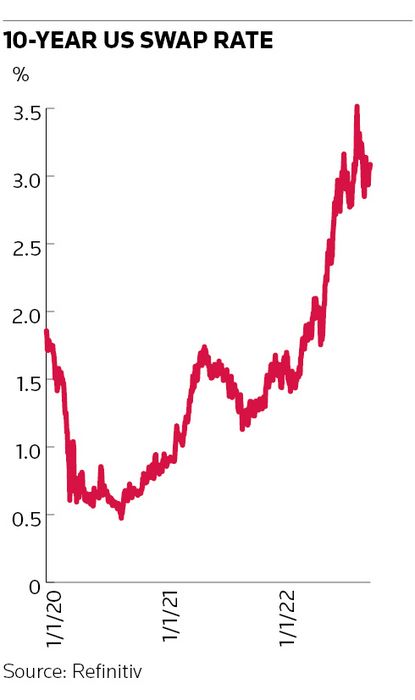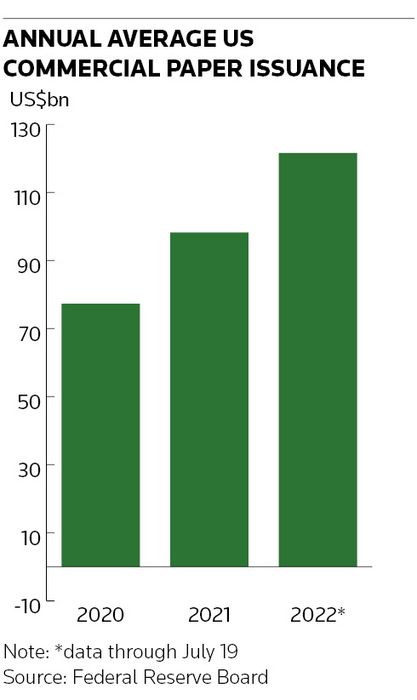This year’s steep rise in financing costs is causing a once-in-a-generation cash crunch for borrowers in capital markets that have used derivatives to hedge their debt issuance, forcing many to scramble to find additional funds to meet margin calls they face on swap positions.
Most issuers, whether it's banks, corporate treasurers or public sector borrowers, will swap the cashflows from their fixed-rate debt to floating interest rates. That can lower their financing costs in the near term, but it leaves them vulnerable to a liquidity squeeze if rates suddenly jerk higher. That is because many have agreed to post collateral – so-called variation margin – to their swaps dealers when the value of their positions moves against them.
One banker noted that a 200bp increase in the 10-year swap rate puts issuers that hedged fixed to floating about 20% out of the money on that position. That means they would have had to post around a fifth of their original borrowing amount as collateral. “That’s huge,” the banker said.
Such moves have been a rarity during the past decade of rock-bottom interest rates. But the backdrop has changed dramatically this year as central banks have moved to tame sky-high inflation. The 10-year US dollar swap rate reached an 11-year high of 3.5% in mid-June, Refinitiv data show. It has since eased to about 2.8%, but has still more than doubled over the past 12 months. Other developed swap markets have notched similar rises.
Those moves would have triggered many billions of dollars in margin calls for companies that had swapped to floating rates at lower levels, forcing them to cast around for more cash at what remains a challenging time for many, especially when it comes to tapping primary debt markets. That has prompted an increase in demand for short-term funding such as commercial paper and repurchase agreements, bankers say, where volumes have surged this year.
“As rates go up, these issuers may have to post meaningful amounts of variation margin on their swaps to cover any mark-to-market moves on those positions,” said Bhaavit Agrawal, head of private placements for rates and currencies at Citigroup. "Given rates in [US dollars and euros] have generally been in a downward trend over the last decade or so, this year is the first sustained episode in a while that issuers are facing liquidity outflows from the hedges of their debt issuance."
“Issuers now need additional liquidity and they’re trying to find it from any source they can," he added.

Margin calls
Quantifying the scale of the industry-wide margin call is difficult as derivatives deals are struck in private. But looking at debt issuance volumes from financial institutions, which are mostly subject to collateral agreements on their swaps, can give a rough idea.
Financial institutions issued US$1.6trn of fixed-rate debt in the Americas alone last year, according to IFR data, at a time when 10-year swap rates averaged 1.4%. If just half that issuance was swapped back to floating, a roughly 200bp increase in swap rates to this year's peak would imply a jump of about US$160bn in variation margin calls for these firms.
There have certainly been signs in short-term funding markets that liquidity demands have increased materially. Repo rates across many European Union markets traded more negatively earlier this year than at the start of 2021, according to CME Group's BrokerTec fixed-income trading platform. That suggests collateral was scarce, particularly across certain specific bonds in core markets. Meanwhile, average daily volumes in European repo markets hit new records in May and June, peaking at €374bn in the week ending June 17 when swap rates reached their highs.
"Increased demand from banks’ swaps desks to fund additional margin requirements could have been a contributing factor to a significant increase in average daily repo volumes across May and June," said John Edwards, global head of BrokerTec.
“That’s set against the longer-term backdrop where repo market activity has been growing considerably over the last three years or so, particularly in European markets. Demand for repo as a secured form of funding has continued to grow as dealers look to meet their financial and capital requirements with high-quality liquid assets.”
Regulatory requirement
Posting collateral against swaps exposure has become more prevalent in recent years as regulators have required a greater proportion of derivatives users to do so. The largest swap dealers held US$286bn of initial margin on uncleared derivatives transactions at the end of 2021, according to ISDA, more than double the level at the end of 2017.
Most financial firms must now post margin, while a growing number of public sector and corporate issuers have signed up voluntarily as well. Nearly 30% of the margin that the top dealers collected last year came from trades not subject to regulatory requirements.
Agreeing to post margin has advantages as well as potential downsides. Jens Hellerup, head of funding and investor relations at the Nordic Investment Bank, said signing a two-way agreement (where collateral can pass both ways between swaps counterparties) has been "positive for us" and helped the public sector borrower increase the size of its funding programme in recent years to between €6bn and €8bn.
“It gave us better pricing, but more importantly it ensured we always have good access to derivatives markets when we need it. Some banks were not happy to quote us when we only had a one-way agreement,” he said.
Hellerup said NIB stress tests its derivatives portfolio to ensure it always has enough liquidity to post collateral for the next 12 months. “If the market moves a lot we will need to re-do our stress tests and that may mean we have to do more funding, but that's not a big issue for us as our funding programme is relatively small. Our funding costs are low, so it doesn’t cost us much to hold excess liquidity."

Market pressures
The Swedish National Debt Office is another public sector borrower with two-way margin agreements. It has had to post more collateral as a result of rising interest rates and some of its swaps moving out the money, Erik Akesson, FX and funding manager, confirmed via email. That has "not had any significant impact on us,” he added, because its swaps book is “relatively limited in size and we only use cash as collateral".
But there are signs elsewhere in markets that not everyone is finding things so comfortable. A senior trader said margin optimisation and how best to manage margin volatility had become major talking points with clients as the rate moves have been so dramatic.
“Margin calls have gone up a lot,” the trader said. “It increases pressure on repo funding markets where people can raise cash for margin calls. We’ve seen that for a while with collateral scarcity in Europe.”
Bankers said many borrowers are looking at commercial paper markets to raise short-term funds to meet margin calls. Average annual US commercial paper issuance was US$122bn as of July 19, according to Federal Reserve data, up 24% from last year.
"The cheapest thing to do is to borrow short-term commercial paper but of course that brings rollover risk," said Citigroup's Agrawal.
Those who think rates will be higher for longer may issue fixed-rate bonds provided they can access primary markets, while others might issue more floating-rate notes to adjust the interest rate sensitivity of their bond issuance. IFR data show FRNs accounted for 36% of Americas financial issuance in the first half of 2022, up from 28% last year.
"Different issuers have different approaches," Agrawal said.